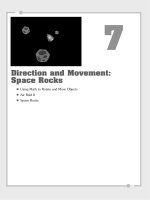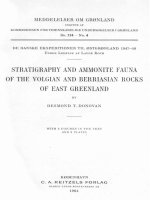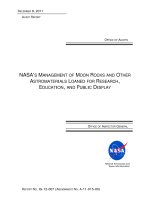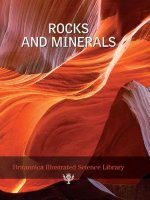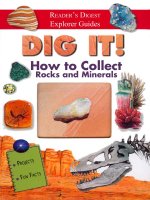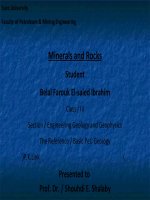caseb rocks minerals
Bạn đang xem bản rút gọn của tài liệu. Xem và tải ngay bản đầy đủ của tài liệu tại đây (696.97 KB, 22 trang )
Properties of
Minerals
Geologists use
characteristics to tell one
mineral from another
Mineral Properties we will study
Luster
Hardness
Cleavage
Streak
Luster
• Refers to the way light reflects
from the surface of the mineral.
• There are two types of luster,
– Metallic: looks like polished metal.
– Nonmetallic: does not look like
polished metal.
• Nonmetallic can be shiny or dull.
Pyrite has metallic luster
Quartz has nonmetallic luster
Hardness
• Is measured by how easy it is to scratch.
• Geologists order the hardness by…
1. Scratched by a fingernail.
2. Scratched by a penny.
3. Scratched by a nail.
4. Scratched by a diamond.
These are not all of the tools geologists use,
but it will work for our experiment.
Gypsum is soft, it can be
scratched by a fingernail.
Calcite is soft, but a little harder
because it cannot be scratched by a
fingernail, but it can be scratched by
a penny.
Fluorite is harder. It can be
scratched by a nail, but not a penny
or fingernail.
Diamonds are the hardest mineral,
so it scratches every mineral.
Cleavage
• Not all minerals have cleavage.
• Some minerals split easily along a
flat surface.
• The number of lines that are
created when a mineral is split will
be the number of cleavage lines.
Mica has cleavage in one
direction.
It breaks along one line.
Feldspar has two lines of
cleavage. It breaks along two
lines.
Streak
• Red chalk on a chalk board makes
red marks. White chalk makes white
marks.
• Not all minerals work this way. When
some minerals are scratched along a
ceramic streak plate, it creates a
different color.
Gold
• When gold is run
across a streak
plate it makes a
yellowish-gold
color.
• That makes
sense.
Pyrite or “Fool’s Gold”
• When pyrite is run
across a streak plate,
it has a black or dark
green streak.
• Pyrite is not worth
much money, while
gold is worth a lot.
They look alike, so
miners call it fool’s
gold.
Hematite
• Hematite’s color is
grey, but its streak is
red.
• Hema means blood.
• The mineral was
named hematite
because it looked like
it was bleeding when
it was taken across a
streak plate.
One mineral
property we will
not use…
COLOR
A mineral can be many different
colors. Below is Mica.
Many minerals can be the same color. Below are
gold colored minerals. Which one is gold?
The answer…
None of them were
real gold.
Just like with people…
Outside color does not tell you
much about the important
characteristics.
